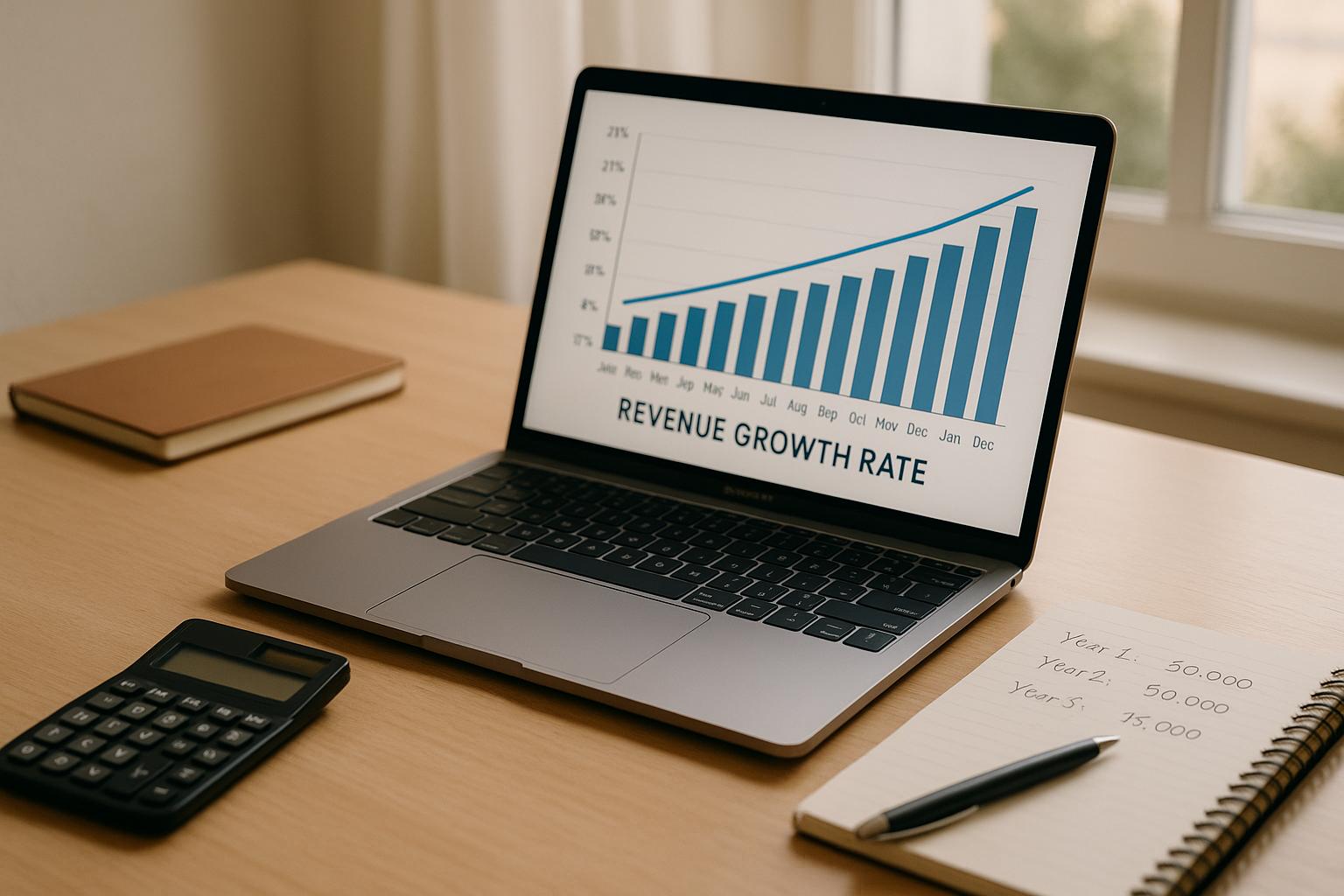How to Build a SaaS Retention Dashboard

Retention is key to SaaS growth. Keeping customers is 9x cheaper than acquiring new ones, and just a 1% increase in Net Revenue Retention (NRR) can boost your company valuation by 18% in five years. A well-designed retention dashboard helps you monitor metrics like churn, NRR, and customer engagement to act fast and reduce risk.
Key Takeaways:
- Core Metrics: Track retention rate, churn rate, NRR, and cohort trends.
- Data Sources: Use CRM tools (e.g., Salesforce), billing platforms (e.g., Stripe), and product analytics for insights.
- Dashboard Tools: Opt for software with real-time updates, customizable visuals, and strong integrations.
- Visuals: Use line graphs, heat maps, and bar charts to simplify data.
- Team Adoption: Schedule short weekly reviews and tailor metrics to roles (Customer Success, Product, Sales, Executives).
By tracking the right metrics and integrating reliable data sources, your dashboard can help reduce churn and drive SaaS success. Let’s dive into the details.
Core Retention Metrics to Monitor
When building a SaaS retention dashboard, it's crucial to keep an eye on metrics that show how well you're retaining customers and increasing their value over time. Here are the key metrics to focus on.
Measuring Customer and Churn Rates
Customer retention rate and churn rate are vital indicators of your business's health. Your customer retention rate measures the percentage of customers you retain during a specific period. For instance, if you start January with 1,000 customers and keep 950 by month's end, your retention rate is 95%.
The retention rate formula is:
(Number of customers retained ÷ Total customers at start of period) × 100
In your dashboard, track both customer churn and revenue churn:
| Churn Type | Formula | Benchmark |
|---|---|---|
| Customer Churn | Lost Customers ÷ Starting Customers × 100 | 3-8% monthly |
| Revenue Churn | Lost MRR ÷ Starting MRR × 100 | 2-4% for mature companies |
Using Cohorts to Track Retention
Cohort analysis groups customers based on when they joined, helping you uncover behavioral trends and retention challenges. Adding cohort visualizations to your dashboard makes it easier to pinpoint bottlenecks and act on them.
Key retention milestones to watch:
| Cohort Metric | What It Reveals |
|---|---|
| Short-Term Retention (30-90 days) | Success of onboarding and initial engagement |
| Annual Retention | Likelihood of long-term customer loyalty |
Tracking Revenue from Existing Customers
Net Revenue Retention (NRR) is a critical metric for understanding revenue growth from your current customer base. Use this formula:
(Starting MRR - Downgrade Revenue - Churned Revenue + Upgrade Revenue) ÷ Starting MRR × 100
For example, if you begin with $100,000 MRR, lose $5,000 to churn, $2,000 to downgrades, and gain $8,000 from upgrades, your NRR would be 101%, signaling growth.
Break your revenue tracking into these categories:
- Upgrade Revenue: Earnings from plan upgrades or add-ons
- Downgrade Revenue: Losses from customers moving to lower plans
- Churned Revenue: Revenue lost due to cancellations
For B2B SaaS, aim for an NRR above 100%. Enterprise-oriented companies often target 125% or more, while SMB-focused companies may consider 90% healthy.
Once you've pinpointed these metrics, the next step is ensuring your dashboard integrates the right tools and data sources.
Tools and Data Requirements
To create a retention dashboard that tracks metrics like NRR and churn effectively, you'll need to pull data from several key systems.
Where to Get Retention Data
Retention dashboards rely on information from CRM systems, billing platforms, and customer interaction tools. Each source plays a specific role in providing critical insights:
| Data Source | Purpose | Key Metrics Provided |
|---|---|---|
| CRM Systems (e.g., Salesforce) | Tracks customer relationships | Account status, engagement levels |
| Billing Platforms (e.g., Stripe) | Monitors revenue activity | MRR, upgrades, downgrades |
| Support Systems | Evaluates customer health | Ticket volume, resolution times |
| Product Analytics | Analyzes usage behavior | Feature adoption, session frequency |
Picking Dashboard Software
Look for dashboard software that offers strong integration options, customizable visuals, real-time updates, and role-based access. Tools like Userpilot can simplify the process with pre-built templates designed for quick setup.
Connecting Your Data Sources
A well-integrated data stack is crucial for accurate reporting. Start by establishing consistent naming conventions across all your data sources. Then, focus on these key integration methods:
| Integration Type | Implementation Method | Purpose |
|---|---|---|
| API Connections & Validation | Direct system linking | Ensures real-time data flow and accuracy |
| UTM Parameters | Campaign tracking | Measures marketing performance |
Make sure to standardize data formats before connecting systems. This step is essential to maintain reliable insights and consistent reporting across all retention metrics.
Once your tools and data sources are integrated, you can shift your attention to designing a dashboard layout that clearly presents retention insights.
Building Your Dashboard
Once your data sources are connected, it's time to design a retention dashboard that's both clear and easy to use. The goal is to arrange metrics in a way that makes sense and keeps everything visually straightforward.
Layout and Organization
Arrange metrics based on their importance. Place critical retention data like retention rate and MRR (Monthly Recurring Revenue) in the top-left section, as this is where attention naturally goes. Group related metrics together to make the dashboard easier to navigate.
| Dashboard Section | Key Metrics to Include |
|---|---|
| Overview Panel | Retention rate, MRR from existing customers |
| Cohort Analysis | Customer cohort retention heatmap |
| Churn Metrics | Customer churn rate, revenue churn rate |
| Revenue Retention | Net and gross revenue retention |
Charts and Graphs for Retention
Use visuals that make your retention data easy to understand. For example:
- Line graphs to show trends over time.
- Heat maps to analyze customer cohorts.
- Bar charts for comparing different customer segments.
- Gauge charts for real-time metrics like retention rates.
"Building a SaaS dashboard requires focus on clarity and usability."
Keep the visuals simple and focused. This approach ensures quick, actionable insights. To make your dashboard even more useful, add filters that allow for deeper exploration of the data.
Adding Data Filters
Filters let users dig deeper into retention metrics. Here are some essential ones to include:
- Time-based filters: Allow users to view data for specific periods, like the last 30 days or quarter-to-date.
- Segment-based filters: Offer filtering by customer attributes such as plan type, company size, or industry.
- Cohort filters: Enable filtering by groups like sign-up date, contract value, or usage patterns.
Keep the interface tidy by showing only the most commonly used filters upfront. Less frequently used options can be tucked away in an advanced settings menu.
sbb-itb-e766981
Dashboard Management and Updates
Keeping a retention dashboard effective requires consistent oversight of data accuracy, team engagement, and regular refinements. By staying on top of these elements, your dashboard can remain a reliable tool for informed decision-making.
Data Quality Control
The accuracy of your data is crucial for trustworthy retention insights. Use automated validation tools to flag inconsistencies early. Establish daily checks to identify unusual patterns or missing data.
| Quality Control Element | Method | Frequency |
|---|---|---|
| Data Validation | Automated scripts | Daily |
| Source Consistency | Cross-reference checks | Weekly |
| Metric Accuracy | Manual reviews | Monthly |
| Data Completeness | Automated monitoring | Real-time |
Once your data is accurate, the next step is integrating the dashboard into your team's routine for better adoption and utility.
Getting Teams to Use the Dashboard
Make the dashboard part of your team's daily process. Schedule short, weekly 15-minute review sessions to discuss retention trends and identify action items.
"Tracking customer lifetime value informs pricing and investment decisions", says a data analytics expert at Phoenix Strategy Group.
Tailor dashboard metrics to specific roles to ensure relevance:
- Customer Success: Focus on cohort retention rates and identifying at-risk accounts.
- Product Teams: Highlight feature usage patterns and engagement metrics.
- Sales: Surface opportunities for expansion revenue and account health scores.
- Executives: Provide high-level retention trends and their revenue impact.
Making Dashboard Improvements
Use tools like Google Analytics to track how the dashboard is being used. Monitor metrics such as login frequency, time spent on specific sections, and popular filters or reports.
Collect team feedback through quarterly surveys and monthly interviews to understand how they use the dashboard and what additional insights they need.
When making updates, implement a version control system to document changes and maintain a clear changelog. Regular improvements will help ensure the dashboard stays aligned with your retention goals.
Conclusion: Making Your Dashboard Work
Key Takeaways
A well-designed retention dashboard acts as a guide for SaaS growth, offering reliable insights through accurate data, essential metrics, and team collaboration.
| Component | Key Consideration | Impact |
|---|---|---|
| Data Quality | Automated validation and daily checks | Better decision-making |
| Core Metrics | Retention rate, churn rate, cohort analysis | Early detection of issues |
| Team Integration | Role-specific views, regular reviews, feedback | Greater adoption and usability |
By focusing on these elements, you're set to start building an effective dashboard.
How to Begin
To get started, connect your key data sources and ensure quality controls are in place. Begin by tracking the most critical metrics before adding more complexity. Encourage team engagement by scheduling quick 15-minute weekly reviews to build consistent usage habits.
How Phoenix Strategy Group Supports You

If you're ready to fast-track your retention dashboard setup, expert help can make things easier. Phoenix Strategy Group's data engineering team specializes in creating dashboards tailored to SaaS needs. Their services include:
- Custom dashboards designed for your specific metrics
- Data integration and quality control measures
- Team training to encourage adoption and effective use
- Continuous optimization and maintenance
With their mix of technical skills and strategic advice, they help businesses turn raw data into actionable strategies. For SaaS companies aiming to grow, Phoenix Strategy Group also offers fractional CFO services to interpret dashboard insights and guide financial decisions that support long-term success.
FAQs
These FAQs cover common questions about retention metrics and dashboards, helping you refine your strategies.
What KPI measures customer retention?
SaaS businesses use a mix of metrics to track customer retention effectively:
| Metric | Purpose | What It Tells You |
|---|---|---|
| Churn Rate | Measures how many customers leave over time | Reflects retention performance |
| Net Promoter Score (NPS) | Evaluates customer loyalty | Indicates likelihood of repeat business |
| Customer Lifetime Value (CLV) | Estimates long-term revenue from a customer | Highlights the financial impact of retention |
Pairing these numbers with customer feedback gives you a deeper understanding of retention trends and areas for growth.
How can cohort analysis improve retention tracking?
Cohort analysis groups customers by shared traits or timeframes, offering a closer look at retention trends. For instance, you can compare retention rates for customers acquired through different campaigns to see which channels bring in the most loyal users.
This method helps pinpoint what’s working (and what isn’t), making it a powerful tool for refining your retention strategies.
What software should I use for my retention dashboard?
Tools like Userpilot and Netsuite are popular for retention tracking, offering pre-designed templates. When selecting software, prioritize:
- Compatibility with your current tools
- Real-time updates
- Customizable charts and graphs
- An interface that’s easy to navigate
How do I ensure dashboard data quality?
Use automated tools to keep data accurate and up-to-date. Establish clear data rules and perform regular checks to ensure the insights you rely on are trustworthy.




